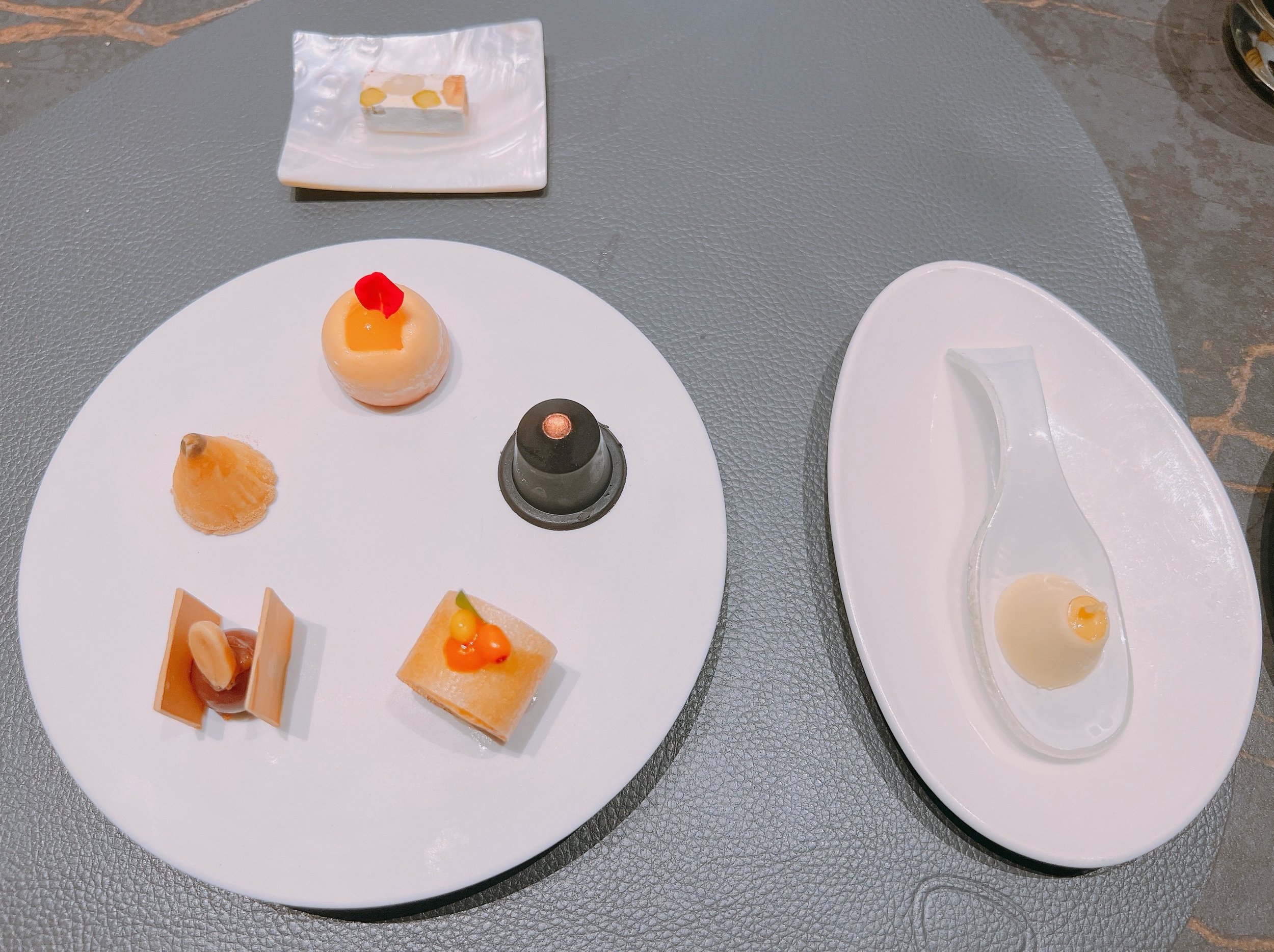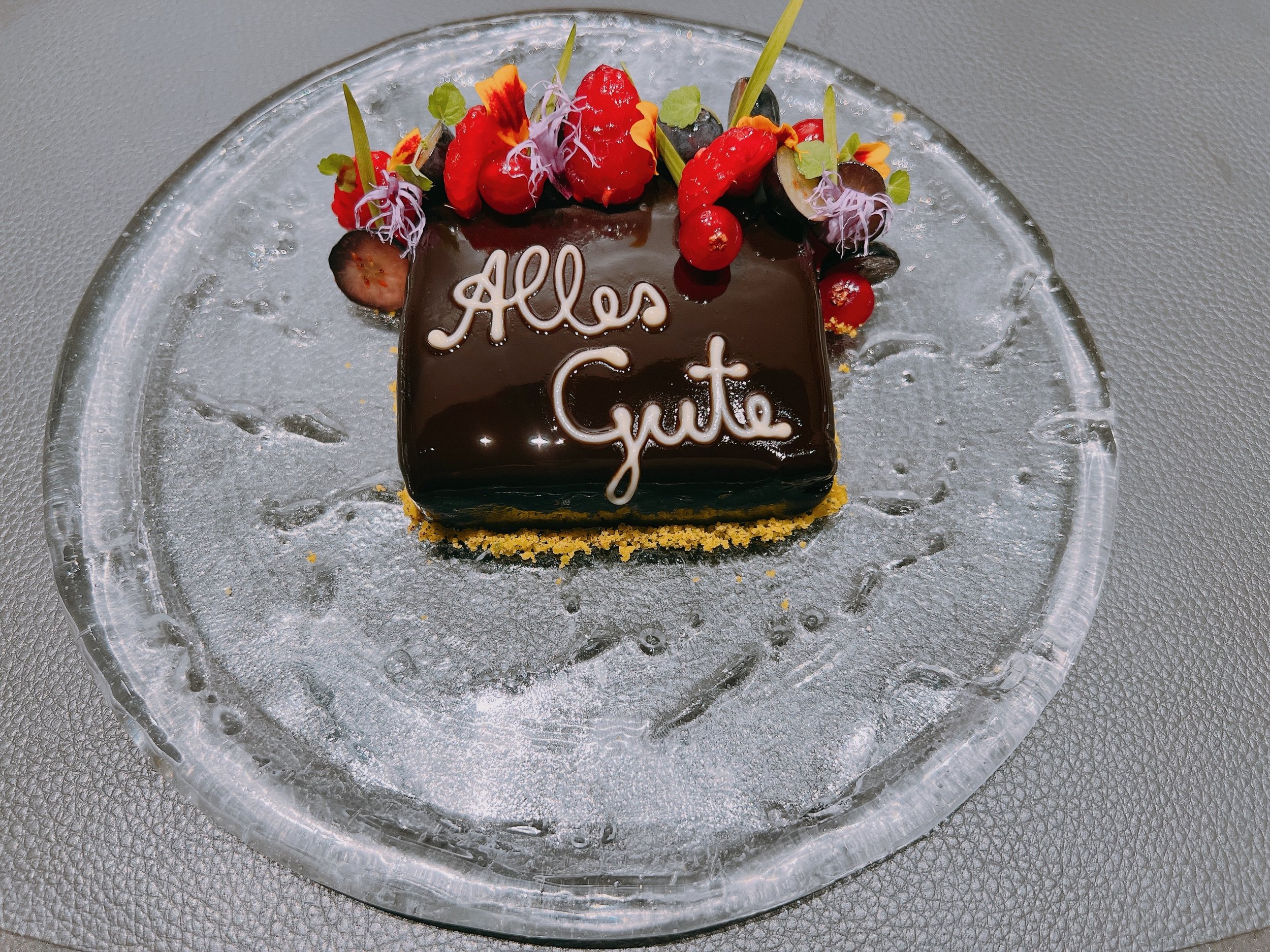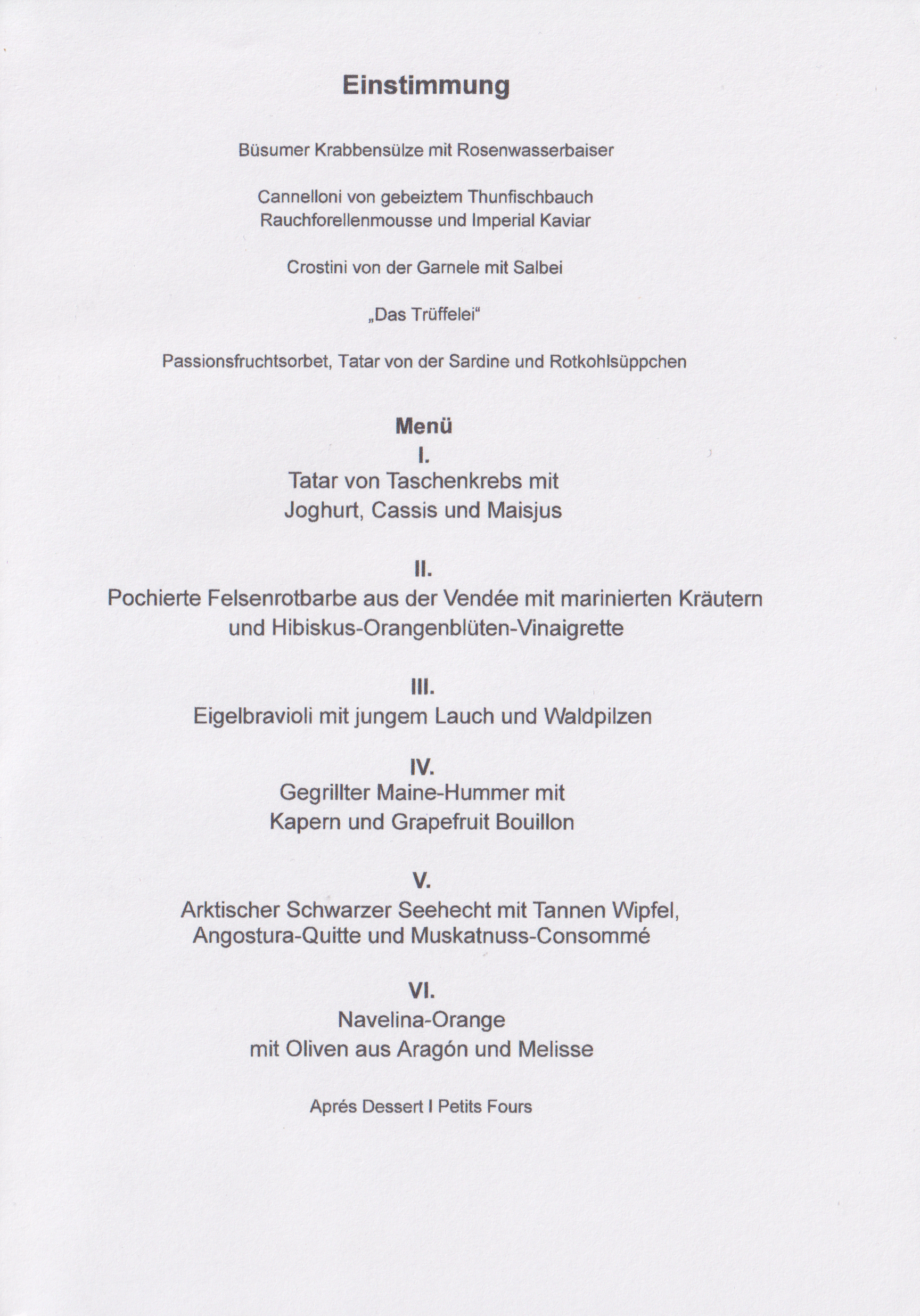schanz - Piesport
Rating: 18/20
Where: Piesport, Germany
When: Dinner for 9 on 4 December 2022
Cost per Person: Tasting menu 208-225 Euro, Wine Pairing 65-112 Euro
Accolades: 3 Michelin Stars
Why: Delicious French cuisine with novel dishes that balance flavors and textures; friendly family-run restaurant and hotel
Schanz (or “schanz. restaurant.”, using the apparently preferred capitalization and punctuation) is the name of Germany's newest three-star Michelin restaurant, and also the name of the family running the restaurant and its associated hotel. The hotel and a winery actually came first, before the family's son joined as the head chef of the eponymous restaurant in 2011. The third Michelin star was earned in 2022.
The restaurant is located in Piesport in the Mosel Valley. On a frosty Sunday afternoon in early December, calling the town sleepy would have been an understatement. We spent our time before dinner walking through deserted streets in search of some caffeine, and established after about an hour of chilly trial and error that there was a total of zero cafes open to sit in and have a coffee, all claims by Google Maps notwithstanding. Seemingly no other businesses were open either - reportedly everything here closes down from November to Easter each year. We found a wine bottle vending machine (!) however, so at least noone is going to suffer from a lack of alcoholic beverages, as befits one of the world's premier wine regions. (There was a happy ending though: a 25 minute walk to next-town-over Minheim led us to lovely Ti's Café, where the Berlin-roasted coffee was excellent. And our exercise amounted to maybe one appetizer's worth of calories to boot.)
Luckily, Schanz restaurant was more “happening” than its hometown, and was almost full during our Sunday night dinner. The decor is modern with dark wooden tables lacking table cloths. Dinners can be a la carte or following a tasting menu, with three to six courses for the latter. Given our group size of nine, we had to preorder a tasting menu of either five (208 Euro) or six courses (225 Euro), and we went for the longer option. Our three pescatarians were not just accommodated, but even received their own printed menus at the beginning of the meal - a nice touch.
Wine pairings and non-alcoholic pairings were available for all tasting menus, ranging from 65 (three courses) to 112 (six courses) Euro. For most courses, there was a choice between two wines for the pairing, one a local wine from the Mosel Valley, and the other wine from around the world. An interesting concept, and it's possible to get two half-pours to try both options. Doing this, I'm a bit sad to report that I consistently liked the non-Mosel wines better, but at least both choices generally went well with the food.
A few appetizers preceded the official six courses of the tasting menu. First a trio. On the right in the picture, a langoustine sage crostini had tiny, crunchy shrimp speared on the fork-shaped cracker. The whole tasted like fancy shrimp chips, but with a much stronger shrimp flavor than the popular Asian snack 18. Next, a cannelloni-shaped cracker was wrapped with a slice of beef, filled with cream, and sported some Imperial caviar at both ends. The dish had a great crunch, which was probably difficult to achieve since the cracker was so thin and “wet” ingredients were on either side of it. With a lovely but light beef flavor, this was very good indeed 19. The pescatarian alternative had tuna instead of beef, and was much, much stronger in flavor. The tuna was excellent, making this dish hard to beat 20. Lastly, minced veal tongue with rose water and jelly was served on a cracker. The crunch was subtle and the dish quite light. Overall very pleasant, but it would have been hard to guess that veal was the main ingredient 18. The pescatarian alternative had king crab instead of veal, resulting in a nice seafood flavor with a tiny bit of sweetness 18.
Breads were served warm and came with grape seed oil, a tomato spread and butter. Scottish white bread rolls, an olive oil cracker, German Schwarzbrot, pretzel rolls and baguettes with hazelnuts all ranged from good to great, with the crackers and Schwarzbrot particularly good, whereas the nuts in the baguette were a bit too soft for my taste. The bread was replenished throughout the meal, so it was hard to stop oneself from filling up on it 18.
Next we were served a signature dish of the house, and the only dish that's always on the menu and indeed part of every tasting menu: the truffle egg. At the bottom of an egg shell were eggs and truffles, and they were topped by a truffly foam. A strong truffle and mushroom flavor was present throughout the dish, and it had a nice combination of textures. Excellent 19.
One last stop before the “official” part of the tasting menu began. A sardine tartare was covered by a foam and a sorbet, both made from passion fruit. The foam was topped by small pieces of marinated red cabbage, and surrounded by a soup of red cabbage. The red cabbage elements were wonderful, and the sardine also excellent, of a good quality and very fishy in taste (this being one of the few fish where that's a plus). But I wasn't a big fan of the passion fruit sorbet, it felt too sweet compared to the rest of the dish, which was more salty/acidic/fatty in character 18.
Time for course #1, about an hour into dinner. Goose liver was served as a kind of cake. On a cracker base we found a goose liver pate, Parmesan Reggiano, small herbs and sherry. Two profiteroles were filled with liver cream, and there was more liver cream on the side, as well as a small brioche on a separate plate. Where to start? The slightly sweet cracker bottom had a wonderful crunch, and went excellently with the goose liver covering it. The brioche went well with the liver cream, but was not too special by itself, and the profiteroles were also a bit ho-hum. But it was nice to have so many different preparations of goose liver. And even better: they were all sweet, but not too sweet, avoiding the trap of the cloyingly sweet dessert-like foie gras dishes seen elsewhere. Several of my dining companions remarked that they usually don’t care about foie gras, but did like this dish quite a lot. Overall 18, maybe higher without profiteroles and brioche.
The pescatarians' course one was completely different. “Edible crab” (sic - I'm glad it wasn’t the other kind) was served with a dollop of caviar, and sauces made of yogurt, black currants and corn, respectively. Small pieces of roasted corn were on the plate as well. I liked the corn and yogurt, which were nice and delicate, but was not too enamored with the crab itself 17.
Course two: poached red mullet sat atop a chopped iceberg salad, a hibiscus orange flower sauce, and drizzles of the poaching liquid. Marinated herbs were on top of the fish. My wife remarked that the preparation was almost like Chinese steamed fish (with ginger and soy sauce), and she was right, there were indeed some echos of that flavor profile. The fish was very light and subtle in flavor, the sauce a bit acidic and the herbs and cabbage added nice textures. Overall, I wish that the fish had been served a bit warmer, but otherwise it was really good 18.
More fish in the third course. Arctic black hake is a very rare fish with strict fishing quotas, and as such seldomly seen on restaurant menus. It was served with a sauce of cardamom, fir oil, wild asparagus and quince. The hake was much fattier than the preceding red mullet, but still delicate in flavor. And it was very, very good. The light, savory, acidic sauce was a perfect match for the fish, only the slightly sweet quince rolls seemed an odd and somewhat unnecessary addition to the dish. Close to perfection 19+.
The pescatarian menu had the black hake as its main course, and inserted an egg yolk ravioli here. It was topped with white truffles, forest mushrooms and a sherry foam. The mushrooms were lovely, and the dish nicely creamy, but I couldn't detect much of a truffle flavor 18.
Maine lobster concluded the series of seafood dishes. It was prepared with slices of pork belly, celery puree, capers, potato chips and a grapefruit bouillon. The lobster itself was not too exciting (read: not too flavorful), and the pork belly seemed steamed and almost a bit mealy - I thought the dish would be better without it. But I did like the slightly bitter grapefruit sauce. The crunchy lattice covering the dish was controversial at our table, some (including myself) thought that it was ok, while others thought it was essentially inedible. It was definitely pretty to look at, but maybe not the best way to add a crunchy textural element to the dish. Overall the weakest of the seafood preparations 16.
Our main course was venison wrapped in nasturtium, and served with sides of marinated radish, potato puree, a praline of deer offal (think kidneys and such), and some porcini mushrooms. This dish unfortunately turned out to be somewhat problematic to rate. Let's start with the non-controversial parts. The potato puree praline was excellent, with both creamy and chopped potatoes. The radish was a bit too sweet for me, and the mushrooms sadly didn't taste of much. The offal praline was pretty good for what it was, but - I have to admit - wasn't entirely my thing. The sauce was slightly peppery and very lovely. The problem was the deer meat itself. My cut was (thankfully) not gamey, but quite mealy in consistency, which was off-putting enough for me to not being able to finish the dish. I was ready to rate this dish as a whole maybe a generous 15, when I heard the rest of the table waxing poetic about the lovely venison. Huh?!? And indeed: sampling from my neighbor's plate revealed a lovely cut of venison, which would have easily scored an 18 or higher. It turns out that two out of the six plates served to our table were sub-par, while the others were excellent. The kitchen (and later even the chef himself) apologized, and offered to redo the dish. I had to decline that kind offer since I was already pretty stuffed at this point. The moral here is that bad ingredients happen sometimes, and there was really no visual difference between the “good” and the “bad” version of venison, but I loved the response from the restaurant. I wouldn't have said anything, but the server clearing my plate inquired about the left-over meat, and the kitchen really cared deeply about making things right. There's not much more that one can ask for. As a consequence, I think it's most appropriate to leave this dish unrated.
Time for desserts (there was no cheese cart in sight here). The first was a combination of oranges and olive oil. Orange sorbet, orange soup and orange foam were served with an herb sorbet and surrounded by olive oil. At first, the olive oil felt a bit weird in this dish, but it did actually go pretty well with the more acidic orange. A refreshing, very nice dessert 18.
Lemon sorbet was served in a celery soup (and inside an egg-shaped bowl that would probably be a most inconvenient dish to have at home). The lemon sorbet was very good, fresh and acidic. The celery soup added a slight vegetable note, but mostly contributed texture due to the diced celery hidden beneath the sorbet 18.
Petit fours rounded out the dinner. The main plate from the top in counter-clockwise order: “Schanz on the beach” was a bite of apricot sorbet topped with a dollop of pineapple gel, very good 18. A filo dough cone filled with marshmallow was also delightful, with a nicely sweet and creamy marshmallow 19. Peanuts and salted caramel were a wonderful combination 19+. Less exciting was a cheese cake inside a thin cracker roll topped with sea buckthorn gel. Not bad, but a bit boring compared to the other bites 17. A Nespresso-capsule-shaped praline had an espresso macchiato flavor, again very good 18. A piece of French nougat was very sweet 18. A spoon with an almond, grand marnier and white chocolate praline was not quite my thing 15.
Given that it was my birthday dinner (not just for myself, but for three other tables as well), I received a birthday cake. It was similar to a spit cake, but flat instead of round. The fruit on top were nice, but the cake itself felt a bit heavy and dry to me 16.
The service was great throughout our dinner, with the sommelier being particularly enthusiastic. My main criticism with our experience would be that that the dining room was way too warm where we sat - it would have been much more comfortable (but maybe not entirely appropriate) to wear only a T-shirt. There were also some gaps between courses that seemed pretty long, and water glasses sat empty for extended durations as well. But that's nitpicks in the end, and the nearly six hours of dinner just flew by.
Overall: The kind of birthday dinner that one hopes for, with great food, great wine, great service, and great company. Excellent dishes throughout, with all of them novel creations by the chef and his kitchen. The techniques might be French, and the flavors French and (to a lesser degree) German, but the main goal here seems to be to balance each dish in terms of taste (acidity, saltiness, sweetness) and textures (creamy, crunchy), and the results are an unequivocal success 18.


















